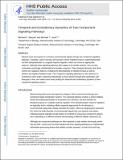Temporal and evolutionary dynamics of two-component signaling pathways
Author(s)
Salazar, Michael Edward; Laub, Michael T
DownloadLander_Temporal and.pdf (692.1Kb)
PUBLISHER_CC
Publisher with Creative Commons License
Creative Commons Attribution
Terms of use
Metadata
Show full item recordAbstract
Bacteria sense and respond to numerous environmental signals through two-component signaling pathways. Typically, a given stimulus will activate a sensor histidine kinase to autophosphorylate and then phosphotransfer to a cognate response regulator, which can mount an appropriate
response. Although these signaling pathways often appear to be simple switches, they can also orchestrate surprisingly sophisticated and complex responses. These temporal dynamics arise from several key regulatory features, including the bifunctionality of histidine kinases as well as
positive and negative feedback loops. Two-component signaling pathways are also dynamic on evolutionary time-scales, expanding dramatically in many species through gene duplication and divergence. Here, we review recent work probing the temporal and evolutionary dynamics of two-component signaling systems.
Date issued
2015-01Department
Massachusetts Institute of Technology. Department of BiologyJournal
Current Opinion in Microbiology
Publisher
Elsevier
Citation
Salazar, Michael E, and Michael T Laub. “Temporal and Evolutionary Dynamics of Two-Component Signaling Pathways.” Current Opinion in Microbiology 24 (2015): 7–14.
Version: Author's final manuscript
ISSN
1369-5274
1369-5274